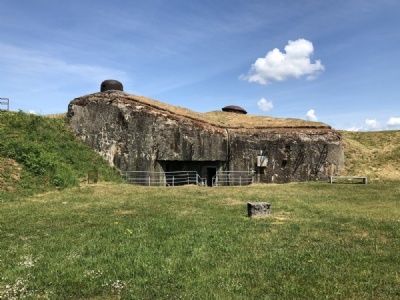Villy-La Ferté
After a long wait caused by constant postponements due to bad weather conditions since the autumn of 1939, "Fall Gelb" (Case Yellow), the German attack on Western Europe began on May 10, 1940. It started with army group B under the leadership of field marshal von Bock made a central attack on Belgium. This was the original plan but had been revised to become a diversionary maneuver. The French army, on the other hand, was prepared for the original plan and had therefore concentrated its forces to face a central attack. The consequence of this strategy was that they left the rear lines unprotected and vulnerable to a rear-end attack. The real plan of attack was launched on May 12 by army group A and was to bypass the French main forces with an attack through the inaccessible and hilly Ardennes in the south.
This was something that the French defenders did not expect and the German armoured troops led by the generals Guderian and Rommel could therefore advance at a rapid pace. Supported by both ground and air forces, they demonstrated tactical skill and took the French army with total surprise. One of the main targets of the German offensive in the Ardennes was the town of Sedan on the Meuse river. The French believed the city could be defended, but with tactical skill the city was captured and German ground and air forces battered French forces in the surroundings and prevented them from destroying important bridges over the Meuse. On May 15, the French attempted a counterattack against the German bridgeheads, but lack of both morality and coordination the attack failed. Once the Germans had secured the city, it could be used as a starting point for an offensive northwards towards the Channel coast, thus enclosing and falling the French defenders in the back.
About twenty kilometres east of Sedan lies Villy-La Ferte and there were fought the hardest battles along the entire part of the Maginot line that was subjected to German attacks. It was at a height and consisted of two fortifications and was manned by about 100 men strong garnisson. The Germans launched a massive attack on May 17, 1940, but the defenders offered fierce resistance and kept on fighting for another two days before the germans could capute the forts. All French defenders died during the defence but were posthumously awarded the Order de l’Armee award. The German commander of the troops attacking the fortification was rewarded with the Knight Cross.
Current status: Preserved with museum (2022).
Location: 49°35' 03.47" N 05°14' 01.54" E
Get there: Car.
Follow up in books: Jackson, Julian: The Fall of France: The Nazi Invasion of 1940 (2003).


















The Battle for France in 1940 is definitely overshadowed by the First World War in France. Not least in this area where the battlefields of World War I are filled with magnificent monuments, museums and cemeteries. Nothing strange about that because the First World War were fought over years in these areas with few territorial conquests, but all the more losses in human life. It was also a war where France ultimately won and has in a way become part of the French people’s soul and a memory they embrace.
The French defeat of 1940 is overshadowed by the First World War but still remembered. There is a lot to discover in the area for those looking. Several bunkers from the Maginot line remain and have become part of the landscape. Other bunkers are hidden in forests and fields, more or less decayed, but still part of history. Well-kept and atmospheric German and French war cemeteries are also available. At Villy-La Ferte there is an excellent museum where it seems that the French have gathered the fighting and historization from the spring of 1940, certainly partly because of the martyrdom its defenders received. The area is well preserved and is beautifully situated on a hill worthy of the battles fought on the site.